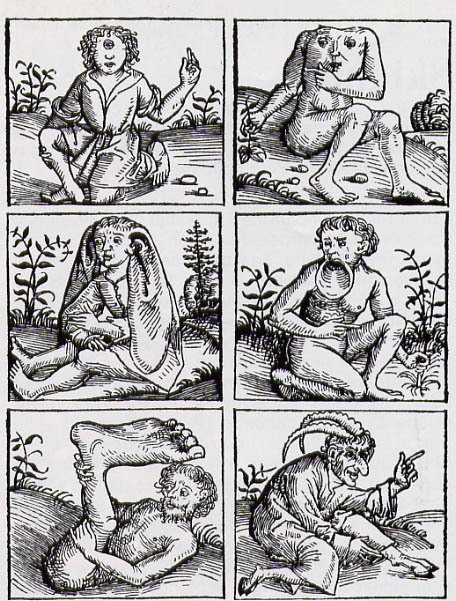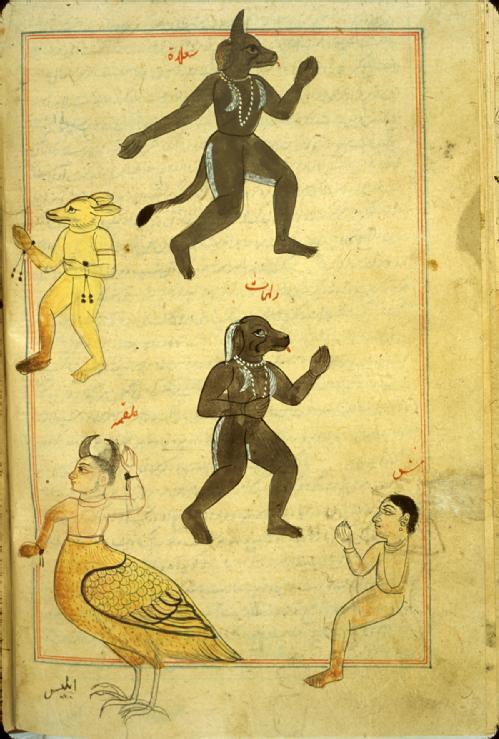Week 7. Maps and Marvels: Travel and Mental Geographies
From the ancient period up to modern times, travel writing and the related discipline of geography have been key domains for the development of human understanding regarding the shape of the world, the diversity of nature, the boundaries of the human, and the character of the foreign. Focusing on maps and geographical writings, this seminar examines how notions of the marvellous and monstrous have shaped perceptions of the world and its inhabitants in the European, Indo-Persian, and East Asian traditions. How do ideas about marvels intersect with empiricism? What do they tell about rationality and modernity? And what is travel's role in disseminating, dispelling, or reconfiguring notions of the wondrous?
Core Reading (read two)
Lorraine Daston and Katherine Park, Wonders and the Order of Nature, 1150-1750 (Cambridge, MA: MIT Press, 1998), pp. 21-39, 60-66. Link.
Surekha Davies, Renaissance Ethnography and the Invention of the Human: New Worlds, Maps and Monsters (Cambridge: Cambridge University Press, 2016), pp. 148-182. Link.
Huynhee Park, 'The Imagined Among the Real: The Country of Women in Traditional and Early Modern Chinese Geographical Accounts and Maps', in: Elizabeth Ketner and Alison Kavey (eds.), Imagining Early Modern Histories (London and New York: Routledge, 2016), pp. 101-124. Link.
Sanjay Subrahmanyam, Empires between Christianity and Islam, 1500-1800 (Albany, NY: SUNY Press, 2019), pp. 276-318. Link.
Primary Sources
Hereford Mappa Mundi (c. 1300).
Martin Behaim Globe (1492). Link and Link.
Nuremberg Chronicle World map (1493).
Zhufan zhi 諸蕃志 (1225), A Chinese Gazetteer of Foreign Lands.
Ajā’ib al-makhlūqāt wa-gharā’ib al-mawjūdāt (Marvels of Things Created and Miraculous Aspects of Things Existing), by Al-Qazwini (1203-1283).
Seminar Questions
- Daston and Park discuss the “embracing of exoticism” (p. 34) in late medieval European travel writing. How have historians interpreted this interest in the foreign? How are the attitudes they describe related to questions regarding political, economic, and natural resources?
- To what extent are the different responses to the foreign described by Daston and Park limited to medieval Europe?
- What do maps offer to our understanding of conceptions of the marvellous and monstrous?
- What can giants on maps tell us about knowledge-making? Why should they not be seen as "signs of the gullibility and general critical limitations of Renaissance minds”? (Davies, p. 181).
- Did the accumulation of empirical evidence lead to more objective views about the foreign and wondrous? Why (not)?
- What does comparison of different global traditions of the exotic tell us about practices of exchange and translation, and the role of travel within that?
Further Reading
Akbari, Suzanne Conklin, Idols in the East: European Representations of Islam and the Orient, 1100–1450 (Ithaca, NY: Cornell University Press, 2012), Ch. 1: 'The Shape of the World'. Link.
Alam, Muzaffar, and Sanjay Subrahmanyam, Writing the Mughal World: Studies on Culture and Politics (New York: Columbia University Press, 2012), Ch. 2: 'The Mughals Look Beyond the Winds'. Link.
Baumgärtner, Ingrid, Nirit Ben-Aryeh Debby, and Katrin Kogman-Appel (eds.), Maps and Travel in the Middle Ages and the Early Modern Period: Knowledge, Imagination, and Visual Culture (Berlin and Boston: De Gruyter, 2019). Link.
Ben-Ami, Ido, 'Wonder in Early Modern Ottoman Society: A Case Study in the History of Emotions', History Compass 17.7 (2019), online. Link.
Campbell, Mary Baine, Wonder and Science: Imagining Worlds in Early Modern Europe (Ithaca and London: Cornell University Press, 2014). Link.
Carey, Daniel, 'The Problem of Credibility in Early Modern Travel', Renaissance Studies 33.4 (2019), pp. 524-547. Link.
Classen, Albrecht (ed.), Travel, Time, and Space in the Middle Ages and Early Modern Time: Explorations of World Perceptions and Processes of Identity Formation (Boston and Berlin: De Gruyter, 2018). Link.
Davies, Surekha, ‘The Wondrous East in the Renaissance Geographical Imagination: Marco Polo, Fra Mauro and Giovanni Battista Ramusio’, History and Anthropology 23.2 (2012), pp. 215-234. Link.
Flores, Jorge, 'Distant Wonders: The Strange and the Marvelous between Mughal India and Habsburg Iberia in the Early Seventeenth Century', Comparative Studies in Society and History 49.3 (2007), pp. 553-581. Link.
Friedman, The Monstrous Races in Medieval Art and Thought (Cambridge, MA: Harvard University Press, 1981).
Greenblatt, Stephen, Marvelous Possessions: The Wonder of the New World (Chicago: University of Chicago Press, 1991), Ch. 2. Link.
Harley, J.B., and David Woodward (eds.), The History of Cartography (3 Vols. Chicago: Chicago University Press, 1987-2007), Link.
Hermes, Nizar F., The [European] Other in Medieval Arabic Literature and Culture: Ninth-Twelfth Century AD (New York: Palgrave MacMillan, 2012). Link.
Higgins, Ian MacLeod, Writing East: The Travels of Sir John Mandeville (Philadelphia: University of Pennsylvania Press, 1997). Link.
Leitch, Stephanie, Mapping Ethnography in Early Modern Germany: New Worlds in Print Culture (New York: Palgrave MacMillan, 2010), Ch. 2: 'Centering the Self: Mapping the Nuremberg Chronicle and the Limits of the World', pp. 17-35. Link.
Lilley, Keith D. (ed.), Mapping Medieval Geographies: Geographical Encounters in the Latin West and Beyond, 300–1600 (Cambridge: Cambridge University Press, 2014). Link.
Mittman, Asa Simon, 'England is the World and the World is England', Postmedieval: a Journal of Medieval Cultural Studies 9 (2018), pp. 15–29. Link.
Nadhiri, Aman Y., Saracens and Franks in 12th-15th Century European and Near Eastern Literature: Perceptions of Self and the Other (London: Routledge, 2016), esp. Ch. 2 ('Al-iFranj: Medieval Muslim Perceptions of Western Europeans') and Ch. 3 (' The Medieval Travel Narrative and the Other in Ibn Fadlān, The Travels of Ibn Jubayr, and Mandeville’s Travels'). Link.
Park, Hyunhee, Mapping the Chinese and Islamic Worlds: Cross-Cultural Exchange in Pre-Modern Asia (Cambridge: Cambridge University Press, 2012). Link.
Pinto, Karen, 'Searchin’ his eyes, lookin’ for traces: Piri Reis’ World Map of 1513 & its Islamic Iconographic Connections (A Reading Through Bagdat 334 and Proust)', The Journal of Ottoman Studies 39 (2012), pp. 63-94. Link.
Ramey, Lynn Tarte, 'Monstrous Alterity in Early Modern Travel Accounts: Lessons from the Ambiguous Medieval Discourse on Humanness', L'Esprit Créateur 48.1 (2008), pp. 81-95. Link.
Romano, John (ed.), Medieval Travel and Travelers: A Reader (Toronto: University of Toronto Press, 2020), Ch. 1: 'Mapping out Journeys'. Link.
Rubiés, Joan Pau, Medieval Ethnographies: European Perceptions of the World Beyond (Farnham: Ashgate, 2009).
Wittkower, Rudolf, 'Marvels of the East: A Study in the History of Monsters', Journal of the Warburg and Courtauld Institutes 5 (1942), pp. 159-197. Link.
Zhang, Cong Ellen, Transformative Journeys: Travel and Culture in Song China (Honolulu: University of Hawaii Press, 2010), Ch. 7: 'Sightseeing and Site Making: Visiting and Inscribing Places', pp. 154-179. Link.
Europe and the Globe, 1350-1700. Oxford Bibliographies. By Julie Berger Hochstrasser.
The History of Cartography. Chicaco University Press. Online PDFs. (check the various Galleries of Colour Illustrations)


.
